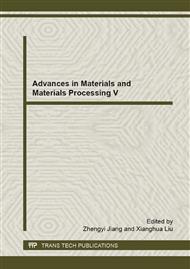[1]
Lee DW, Lee CH, Yun HC, Kim CH, Cho WO: A Study of Tribological Characteristics in Magneto-Rheological Elastomer, Journal of Tribology, vol. 135, (2013), p.014501. 1-5.
DOI: 10.1115/1.4023080
Google Scholar
[2]
Lee CH, Jang MG: Virtual Surface Characteristics of a Tactile Display Using Magneto-Rheological Fluid, Sensors, vol. 118, (2011), pp.2845-2856.
DOI: 10.3390/s110302845
Google Scholar
[3]
Deng HX, Gong XL, Wang LH: Development of an adaptive tuned vibration absorber with magnetorheological elastomer, Smart Materials and Structures, vol. 15, (2006), pp.111-116.
DOI: 10.1088/0964-1726/15/5/n02
Google Scholar
[4]
Dyke SJ, Spencer BF, Sain MK and Carlson JD: An Experimental Study of MR Damp-ers for seismic Protection, Smart Material andStructure, vol. 7, (1998), pp.693-703.
DOI: 10.1088/0964-1726/7/5/012
Google Scholar
[5]
Kang DH, Seo MY, Gimm HK, Kim TW: Determination of Shock Absorption Performance and Shear Modulus of Rubbers by Drop Impact Test, KSME-A, vol. 33, (2009), pp.321-328.
DOI: 10.3795/ksme-a.2009.33.4.321
Google Scholar
[6]
Maeda M, Takeda T, Nakajima K, Shibusawa M, Kurokawa K, Shimada A, Takayama K, Ishigami K: In Search of Necessary Mouthguard Thickness. Part 1: From the Viewpoint of Shock Absorption Ability, Nihon HotetsuShikaGakkaiZasshi, vol. 52, (2008).
DOI: 10.2186/jjps.52.211
Google Scholar
[7]
Huang TJ, Chang LT: Design and evaluation of shock-absorbing rubber tile for play grund safety, Materials and Design, vol. 30, (2009), pp.3819-3823.
DOI: 10.1016/j.matdes.2008.12.024
Google Scholar
[8]
Lee CH, Park JH, Lee ES, Cho WO, Kim CH, Kim NG: Vibration Damping of Hollow Shaft by using Magnetorheological Elastomer, International Congress on Sound and Vibration (2012).
Google Scholar
[9]
Zhou GY: Shear Properties of a MagnetofheologicalEalstomer, Institute of Physics Publishing, (2003), pp.139-146.
Google Scholar
[10]
Luo RK, Green ER, Morrison CJ: Impact damage analysis of composite plates, International Journal of Impact Engineering, vol. 22, (1999), pp.435-447.
DOI: 10.1016/s0734-743x(98)00056-6
Google Scholar
[11]
Tan VBC, Ching TW: Computational simulation of fabric armour subjected to ballistic impacts, International Journal of Impact Engineering, vol. 32, (2006), pp.1737-1751.
DOI: 10.1016/j.ijimpeng.2005.05.006
Google Scholar
[12]
Silva RM, Rodrigues JL, Pinto VV, Ferreira MJ, Russo R, Pereira CM: Evaluation of shock absorption properties of rubber materials regarding footwear applications, Polymer Testing, vol. 28, (2009), pp.642-647.
DOI: 10.1016/j.polymertesting.2009.05.007
Google Scholar


